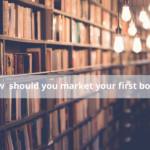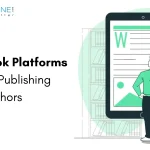Imagine a time when books were only available in physical form, and publishing houses were the gatekeepers of the literary world. But then, technology arrived, and it brought with it a new wave of disruption that shook the publishing industry to its core.
Gone were the days of typewriters and printing presses. Now, authors could write their manuscripts on computers and send them electronically to editors and publishers. And with the advent of e-readers, readers could access entire libraries of books with just a few clicks.
Read: Learn How to Promote Your Book on Social Media Effectively.
But it wasn’t just the way books were created and distributed that changed. Technology also revolutionised the way publishers marketed their books. They no longer had to rely solely on print advertisements or book tours. Now, they could use social media and other online channels to reach readers all over the world.
Perhaps the most significant impact of technology on the publishing industry, however, has been the rise of self-publishing. No longer did authors have to rely on the approval of traditional publishers to get their books into the hands of readers. They could now bypass the gatekeepers and upload their books directly to online retailers, giving them unprecedented control over their work.
So, in many ways, technology has transformed the publishing industry from a closed, exclusive club to a more open, democratic space where anyone with a story to tell can find an audience. And who knows what other disruptive technologies are on the horizon, waiting to shake things up again? Only time will tell.
You may also like: Too Good To Be True a Book By Prajakata Koli
What are the merits and demerits of technology in the publishing industry?
The publishing industry has been transformed by technology in recent years, and while there are certainly benefits to these changes, there are also some drawbacks to consider.
On the positive side, technology has made it easier than ever for authors to get their work published. With the rise of self-publishing platforms, anyone with a story to tell can upload their book and make it available to a global audience. This has opened up new opportunities for diverse voices and has made the publishing industry more inclusive.
Technology has also made it possible for publishers to distribute books more widely than ever before. E-books and audiobooks can be purchased and downloaded instantly, and readers can access an almost limitless selection of titles online. This has made it more convenient for readers to find and purchase books, and has given publishers a wider reach than they ever had before.
However, there are also some downsides to technology in the publishing industry. One of the biggest concerns is the impact on traditional bookstores, which have struggled to compete with the rise of online retailers. As more and more readers turn to digital formats, physical bookstores are closing at an alarming rate, and this loss of community and cultural space is a cause for concern.
Read: Learn How to Publish an eBook with BlueRoseONE.com in easy steps.
Another issue is the increasing dominance of large online retailers, such as Amazon, which control a significant portion of the publishing market. This can make it difficult for smaller publishers and independent bookstores to compete, and can limit the diversity of voices and perspectives available to readers.
The impact of technology on the publishing industry is complex and multifaceted. While there are certainly benefits to the changes brought about by technology, there are also challenges that must be addressed if we want to ensure a vibrant and diverse publishing industry for years to come.
Impact of internet on the publishing industry
The internet has had a profound impact on the publishing industry, transforming the way books are created, distributed, and consumed. With the click of a button, readers can access an almost limitless selection of titles, while authors and publishers can reach a global audience like never before.
One of the most significant changes brought about by the internet is the rise of digital publishing. E-books, audiobooks, and other digital formats have made it possible for readers to access books instantly, from anywhere in the world. This has expanded the reach of publishers and authors, and has made it easier than ever to discover new voices and perspectives.
The internet has also made it easier for authors to self-publish their work. With online platforms like Amazon’s Kindle Direct Publishing, writers can upload their manuscripts and make them available to readers without the need for traditional publishing houses. This has given more control to the authors and has increased the amount of content available for readers to choose from.
In addition, the internet has provided new opportunities for publishers to market and promote their books. Social media and other online channels can be used to reach a wider audience and build relationships with readers, while data analysis tools can be used to better understand reader behaviour and preferences.
Read: What is Em Dash? Learn When to Use an Em Dash in a Sentence.
However, the internet has also brought some challenges to the publishing industry. Traditional bookstores have struggled to compete with the rise of online retailers, and some have been forced to close their doors. The dominance of large online retailers like Amazon has also raised concerns about the concentration of power in the industry, and the potential for a lack of diversity in the books available to readers.
The influence of the internet on the publishing industry has been both positive and negative. While it has opened up new opportunities and expanded the reach of books, it has also brought challenges that must be addressed if we want to ensure a vibrant and diverse publishing industry for years to come.
You may also read: 10 Best Books on Writing Every Aspiring Author Should Read
What good effects has the internet had on the publishing sector?
The internet has had a number of positive impacts on the publishing industry, revolutionising the way books are created, distributed, and consumed.
One of the most significant benefits of the internet has been the rise of digital publishing. E-books and audiobooks can be purchased and downloaded instantly, making it easier for readers to access books from anywhere in the world. This has expanded the reach of publishers and authors, making it possible for more diverse voices and perspectives to be heard.
In addition, the internet has made it easier for authors to self-publish their work. With online platforms like Amazon’s Kindle Direct Publishing, writers can upload their manuscripts and make them available to readers without the need for traditional publishing houses. This has given more control to the authors, allowing them to take charge of the publishing process and reach their readers directly.
The internet has also provided new opportunities for publishers to market and promote their books. Social media and other online channels can be used to reach a wider audience and build relationships with readers, while data analysis tools can be used to better understand reader behaviour and preferences. This has made it easier for publishers to connect with readers and create a more personalised reading experience.
Finally, the internet has made it easier for readers to discover new books and authors. Online bookstores and review sites can help readers find books that match their interests, while online communities and book clubs can provide a space for readers to connect with others who share their passion for reading.
In general, the internet has benefited the publishing sector by creating new options for writers, publishers, and readers. The internet has contributed to the development of a more lively and diversified literary world by facilitating greater access to and sharing of books.
You may also like: Author podcasts vs Writing Workshops: Which is better for you?
What negative effects has the internet had on the publishing sector?
While the internet has brought many benefits to the publishing industry, it has also had some negative impacts that must be considered.
One of the biggest challenges has been the rise of online retailers like Amazon, which have disrupted traditional bookstores and publishers. As more readers turn to digital formats, physical bookstores have struggled to compete, leading to a loss of community and cultural space. In addition, the dominance of large online retailers has raised concerns about the concentration of power in the industry and the potential for a lack of diversity in the books available to readers.
Another issue is the ease with which digital content can be copied and distributed without permission, leading to issues of piracy and copyright infringement. This has had a significant impact on the industry, with publishers and authors struggling to protect their work and maintain their income.
The internet has also brought challenges to the editorial process, with the rise of self-publishing platforms leading to a flood of content that may not have been subject to the same level of scrutiny and editing as traditionally published works. This has made it more difficult for readers to discern quality and has led to concerns about the overall standards of the industry.
Finally, the internet has brought concerns around privacy and data protection, with publishers and online retailers gathering large amounts of data on readers’ preferences and behaviours. While this can be used to create more personalised reading experiences, it also raises concerns about how this data is being used and whether readers’ privacy is being respected.
As a whole, the internet has helped the publishing business in many ways, but it has also had significant drawbacks that need to be resolved if we want to keep it growing and thriving for years to come.
Before technology and the internet, how did the publishing industry function?
Before the rise of technology and the internet, the publishing industry operated in a very different way. Books were produced using traditional printing methods, with metal type set by hand and pressed onto paper using a printing press. This was a slow and labor-intensive process, and meant that books had to be printed in large quantities in order to be economically viable.
In addition, the distribution of books was largely dependent on physical bookstores and libraries. Publishers would print large quantities of books and ship them to bookstores around the country, where they would be sold to readers. This made it difficult for authors and publishers to reach a global audience, and meant that books had to be carefully selected and marketed to ensure that they would sell well.
Read: Here’s a list of 7 Best Time Management Books to Read on Kindle Unlimited.
In the days before the internet, marketing and advertising were also significantly different. To advertise their works, publishers would rely on conventional advertising mediums like newspapers and journals as well as book reviews in well-known periodicals. To promote their works and engage with readers, authors frequently embarked on book tours that included in-person visits to bookshops and libraries.
In general, the publishing sector was slower, more centralised, and more dependent on actual bookstores and libraries before technology and the internet. While this made it more challenging to connect with a global audience, it also emphasised the value of literary culture as a shared experience and fostered a strong sense of community around reading and books.
You may also read: What is Cozy Mystery? A Beginner’s Complete Guide
Has technology and the internet helped to make a change in the publishing industry?
Yes, technology and the internet have brought about significant changes in the publishing industry, transforming the way books are created, distributed, and consumed.
The rise of digital publishing has been one of the biggest changes brought about by technology and the internet. E-books and audiobooks can be purchased and downloaded instantly, making it easier for readers to access books from anywhere in the world. This has expanded the reach of publishers and authors, making it possible for more diverse voices and perspectives to be heard.
In addition, technology has made it easier for authors to self-publish their work. With online platforms like Amazon’s Kindle Direct Publishing, writers can upload their manuscripts and make them available to readers without the need for traditional publishing houses. This has given more control to the authors, allowing them to take charge of the publishing process and reach their readers directly.
The internet has also provided new opportunities for publishers to market and promote their books. Social media and other online channels can be used to reach a wider audience and build relationships with readers, while data analysis tools can be used to better understand reader behaviour and preferences. This has made it easier for publishers to connect with readers and create a more personalised reading experience.
In all, the publishing business has undergone tremendous change as a result of technology and the internet, creating new possibilities for writers, publishers, and consumers alike. Despite certain difficulties and bad effects, the industry has grown to embrace new technology and possibilities, making the literary world more dynamic and diversified.
You may also like: How to Write An Epilogue: Step-By-Step Guide
Publishing
Publishing refers to the process of producing and distributing books, magazines, newspapers, or other types of written or digital content. The publishing process involves various steps, including selecting and acquiring content, editing and formatting the content for publication, designing and printing the final product, and distributing it to readers.
Publishing can be done through traditional print methods, such as offset printing, or through digital methods, such as e-books or audiobooks. Publishers work with authors, editors, designers, printers, and distributors to bring their content to readers.
Publishers are in charge of not only creating and disseminating material but also marketing and promoting their works. This entails developing a brand and marketing plan, connecting with potential customers, and forging bonds with booksellers, critics, and other business insiders.
Read: Here’s a list of 10 Most Famous Self-Published Authors in India.
As a whole, the publishing sector is a complex and varied one that has a significant impact on the cultural landscape and introduces fresh concepts and narratives to readers all over the world.
Types of publishing
There are several types of publishing, each with its own unique characteristics and processes. Here are some of the most common types of publishing:
- Trade publishing: This is the type of publishing most people are familiar with. Trade publishers produce books for the general public and aim to make a profit by selling these books through bookstores, online retailers, and other outlets. Trade publishers work with authors to edit, design, print, and distribute their books.
- Academic publishing: Academic publishers produce books and journals for the academic community. These publications are typically peer-reviewed and aim to contribute to scholarly research and knowledge. Academic publishers work with authors who are experts in their fields and are responsible for ensuring the quality and accuracy of the content.
- Educational publishing: Educational publishers produce textbooks and other materials for use in schools and colleges. These materials are designed to support the learning process and are often created in collaboration with teachers and educational experts.
- Self-publishing: Self-publishing is a type of publishing where authors take on the responsibility of producing and distributing their own books. This can be done through online platforms like Amazon’s Kindle Direct Publishing or through print-on-demand services. Self-publishing gives authors more control over the publishing process but also requires them to take on all the risks and expenses involved.
- Magazine publishing: Magazine publishers produce regular publications focused on specific topics or interests, such as fashion, news, or sports. Magazine publishers work with writers, photographers, and designers to create engaging content that appeals to their target audience.
These are just a few of the many types of publishing that exist. Each type has its own unique challenges and opportunities, but all share a common goal of bringing new ideas and stories to readers around the world.
Publish your book for free with BlueRoseONE and become a bestselling author. Don’t let your dream of becoming an author fade away, grab the opportunity now and publish your book – be it fiction, non fiction, poetry or more.
You may also like: List of 10 Best Libraries in Portsmouth for Book Lovers
















